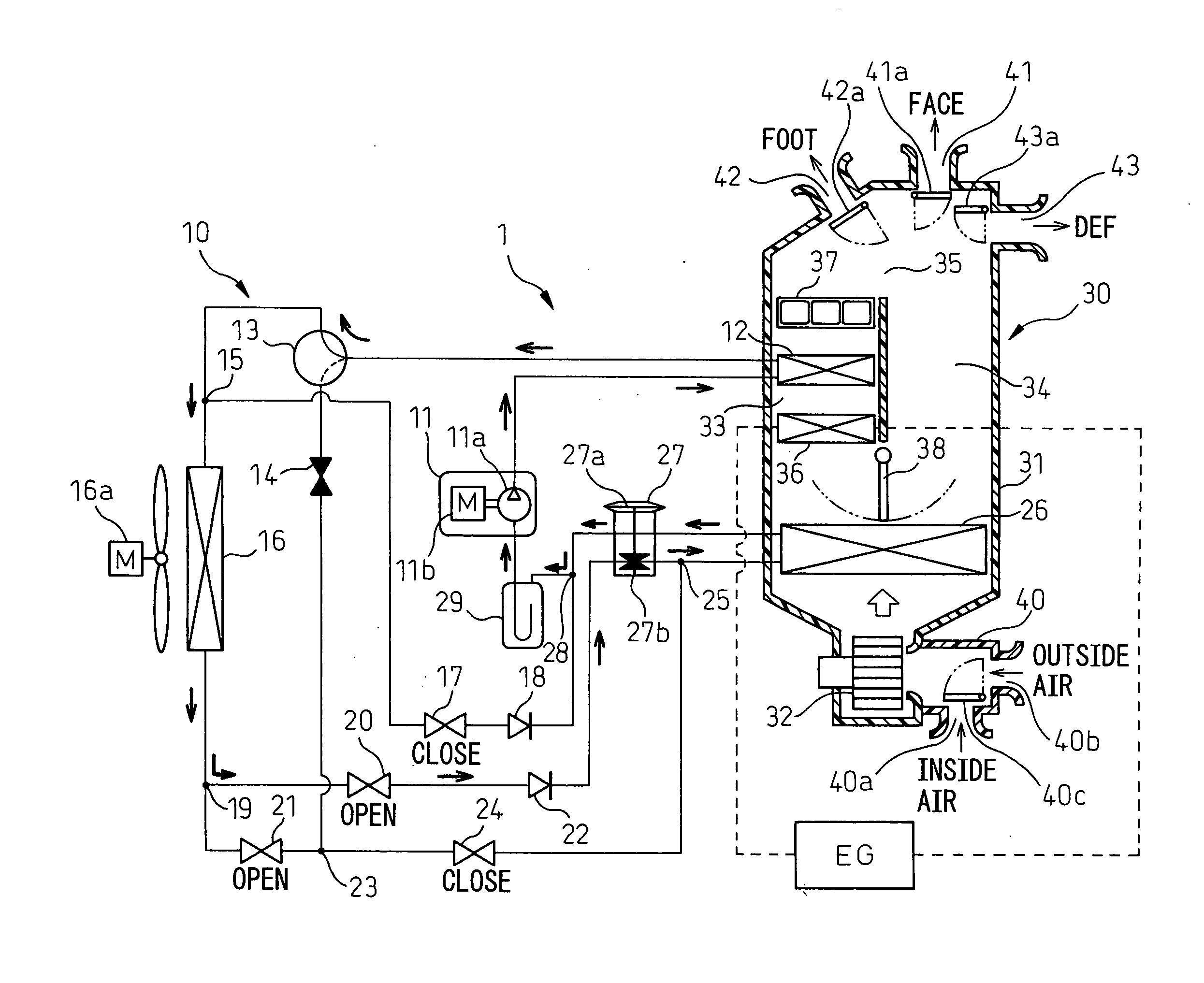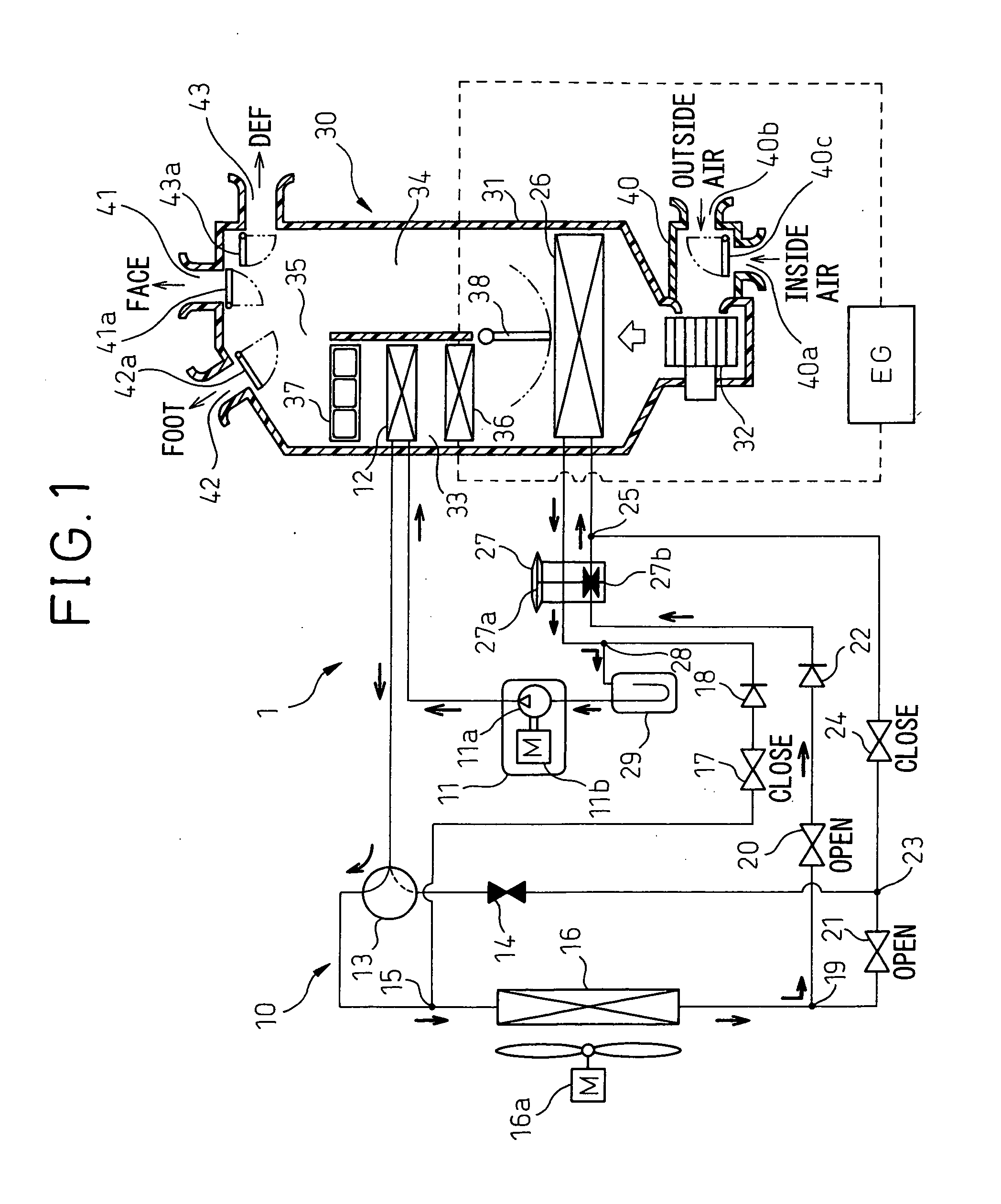Vehicular air-conditioning system
a technology of air-conditioning system and window glass, which is applied in the direction of ventilation system, vehicle cleaning, heating types, etc., can solve the problems of drop in the heat exchange efficiency of the outside heat exchanger, and achieve the effect of improving the defogging ability of the window glass and improving practicality
- Summary
- Abstract
- Description
- Claims
- Application Information
AI Technical Summary
Benefits of technology
Problems solved by technology
Method used
Image
Examples
first embodiment
[0070]FIG. 1 to FIG. 9 will be used to explain a first embodiment of the present invention. In the present embodiment, the vehicular air-conditioning system of the present invention is applied to a so-called hybrid vehicle obtaining drive power for vehicle operation from an internal combustion engine (engine) EG and a drive use electric motor. FIG. 1 to FIG. 4 are overall views of the configuration of the vehicular air-conditioning system 1.
[0071]This vehicular air-conditioning system is provided with a vapor compression type refrigeration cycle 10 configured to be able to switch among refrigerant circuits of a cooling mode cooling an inside of a cabin (COOL cycle), a heating mode heating the inside of the cabin (HOT cycle), a first drying mode drying the inside of the cabin (DRY EVA cycle), and a second drying mode (DRY ALL cycle). FIG. 1 to FIG. 4 show the flows of refrigerant at the time of the cooling mode, heating mode, and first and second drying modes by solid line arrows.
[00...
second embodiment
[0230]FIG. 10 is a flowchart showing main parts of step S6 in the present second embodiment. The control processing of the flowchart of FIG. 10 is executed when the air-conditioner switch 60a and auto switch are on (ON) etc.
[0231]First, at step S60, it is judged if the time is that for pre-air-conditioning. When it is judged that the time is that for pre-air-conditioning (case of YES judgment), the routine proceeds to step S61 where it is judged if the outside air temperature is lower than a predetermined threshold value (in the example of FIG. 10, −3° C.)
[0232]When it is judged that the outside air temperature is lower than a predetermined threshold value (case of YES judgment), the routine proceeds to step S62 where it is decided to activate the PTC heaters 37. That is, at the time of pre-air-conditioning, the power switch of the hybrid system of the vehicle is off (OFF) in state, so the engine EG cannot be started up. For this reason, it is not possible to raise the cooling water...
third embodiment
[0251]In the above first embodiment, when the mode is the DEF and manual F / D and the cooler cycle is selected, the heat source required for heating is secured by the engine cooling water, but in the present third embodiment, as shown in FIG. 11, when the mode is the DEF and manual F / D and the cooler cycle is selected, the heat source required for heating is secured by the PTC heaters 37.
[0252]The flowchart of FIG. 11 changes the steps S33 and S34 of the flowchart of FIG. 9 to step S83, but otherwise is the same as the flowchart of FIG. 9.
[0253]When it is judged at step S82 (corresponding to step S32 of FIG. 9) that the window glass surface relative humidity RHW is higher than 90 (case of YES judgment), it is judged that there is the possibility of window fogging and the routine proceeds to step S83 where the number of PTC heaters 37 operated is increased to secure the heat sources required for heating.
[0254]In this embodiment, the number of PTC heaters 37 operated (number powered) i...
PUM
 Login to View More
Login to View More Abstract
Description
Claims
Application Information
 Login to View More
Login to View More - R&D
- Intellectual Property
- Life Sciences
- Materials
- Tech Scout
- Unparalleled Data Quality
- Higher Quality Content
- 60% Fewer Hallucinations
Browse by: Latest US Patents, China's latest patents, Technical Efficacy Thesaurus, Application Domain, Technology Topic, Popular Technical Reports.
© 2025 PatSnap. All rights reserved.Legal|Privacy policy|Modern Slavery Act Transparency Statement|Sitemap|About US| Contact US: help@patsnap.com



